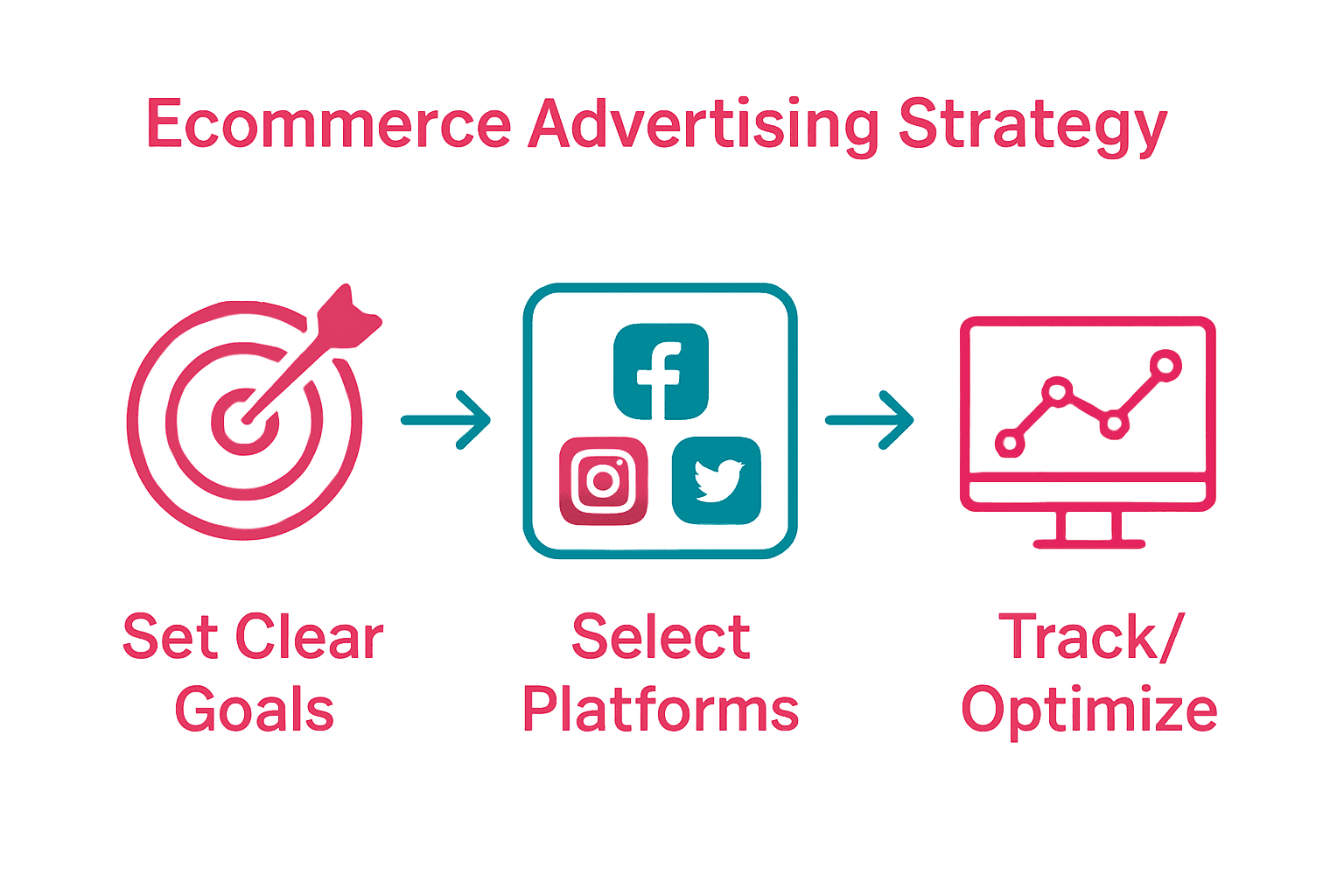Ecommerce Advertising Guide: Boost Sales with Expert Strategy
- Darren Burns
- 7 hours ago
- 8 min read

Nearly 80 percent of ecommerce businesses struggle to turn ad spend into real growth. The power of a strong advertising strategy can make the difference between wasted budgets and skyrocketing sales. Understanding each step—from setting clear goals to refining campaigns—gives you a structured path to outperform competitors and boost your bottom line. This guide gives you the proven framework for smarter advertising that actually delivers measurable results.
Table of Contents
Quick Summary
Step 1: Assess Your Ecommerce Advertising Goals
Successful ecommerce advertising starts with crystal clear objectives. Your advertising strategy needs a precise roadmap that transforms vague hopes into measurable outcomes.
According to research from Eric.ed.gov, defining key performance indicators (KPIs) is fundamental for tracking advertising success. This means moving beyond generic goals like “sell more” to specific targets such as “increase conversion rate by 15 percent” or “reduce customer acquisition cost by £20 per sale”.
When establishing your advertising goals, consider these strategic approaches:
Revenue Generation: Specific sales targets for new and existing product lines
Customer Acquisition: Precise number of new customers within a defined period
Brand Awareness: Measurable metrics like website traffic or social media engagement
Market Expansion: Targeting new customer segments or geographical regions
A crucial warning emerges from Eric.ed.gov: not all advertising objectives are equal. Your goals must be realistic, time bound, and directly connected to your broader business strategy. This means understanding your current market position, available resources, and competitive landscape.
Once you have crystallised your advertising objectives, you are ready to move forward with selecting appropriate advertising channels and designing targeted campaigns. 7 Digital Advertising Types Every Ecommerce Owner Should Know can provide deeper insights into potential advertising strategies that align with your newly defined goals.
Step 2: Select the Best Advertising Platforms
Choosing the right advertising platforms is crucial for maximising your ecommerce marketing effectiveness. Your goal is to identify channels that align perfectly with your target audience and business objectives.
Research from Eric.ed.gov highlights three primary internet advertising approaches mass marketing, direct marketing, and interactive marketing. Each platform offers unique strengths for ecommerce businesses. Social media platforms like Facebook and Instagram excel at targeted demographic advertising. Google Ads provides powerful search intent targeting. Meanwhile, platforms like Pinterest work exceptionally well for visually driven product marketing.
When evaluating advertising platforms, consider these strategic factors:
Audience Demographics: Match platform user base with your target customer
Cost Per Acquisition: Calculate potential return on investment for each channel
Targeting Capabilities: Assess precision of audience segmentation tools
Ad Format Compatibility: Ensure platform supports your preferred creative style

According to Eric.ed.gov, keyword bidding strategies significantly impact campaign success. This means understanding each platform algorithmic nuances and developing sophisticated targeting approaches.
For deeper insights into digital marketing strategies that complement your platform selection, explore our guide on Ecommerce PPC Explained which provides comprehensive tactics for online advertising success.
Step 3: Set Up Tracking and Analytics Tools
Tracking and analytics are the backbone of understanding your ecommerce advertising performance. Your mission is to implement robust measurement systems that transform raw data into actionable insights.
Research from NCBI PMC highlights the critical importance of systematic web analytics assessment. For ecommerce businesses, this means setting up comprehensive tracking tools that go beyond surface level metrics.
Key analytics tools to consider:
Google Analytics: Comprehensive platform for website performance tracking
Facebook Pixel: Advanced conversion and audience tracking for social campaigns
Google Tag Manager: Streamlined tag implementation across multiple platforms
Heat Mapping Tools: Visual representation of user interaction and behaviour
According to NCBI PMC, effective digital data evaluation requires strategic approaches to capturing and interpreting user interactions. This means configuring your analytics to track specific conversion events like product views, cart additions, and completed purchases.
A crucial warning: improperly configured tracking can lead to incomplete or misleading data.
Always double check your event tracking and ensure all key conversion points are monitored.
To enhance your analytics strategy, explore our 7 Essential Types of Digital Marketing for Ecommerce Success guide for deeper insights into comprehensive marketing measurement.
Step 4: Create and Launch Targeted Ad Campaigns
Targeted ad campaigns are the precision instruments of digital marketing. Your objective is to craft compelling advertisements that speak directly to specific customer segments and drive meaningful engagement.
Research from NCBI PMC reveals critical strategies for successful online marketing campaigns, emphasising the importance of audience engagement. This means moving beyond generic messaging to create personalised experiences that resonate with distinct customer groups.
Key elements of successful targeted ad campaigns include:
Audience Segmentation: Break down your customer base into specific demographic and behavioural groups
Compelling Creative: Develop visually striking and emotionally compelling ad designs
Persuasive Copywriting: Craft messages that address specific customer pain points
Dynamic Retargeting: Re engage potential customers who have previously interacted with your brand
According to NCBI PMC, effective digital campaigns require sophisticated data evaluation techniques. This translates to continuous monitoring and refinement of your advertising approach based on real time performance metrics.
A critical warning for advertisers: never treat your ad campaigns as static entities.

The most successful marketing strategies are those that remain agile and responsive to changing audience behaviours.
For a comprehensive deep dive into digital marketing strategies that can elevate your ad campaigns, check out our guide on Ecommerce PPC Explained which offers advanced tactics for online advertising success.
Step 5: Optimise Campaigns for Performance
Optimising your advertising campaigns is an ongoing process of strategic refinement and data driven decision making. Your mission is to transform raw performance data into actionable insights that continuously improve campaign effectiveness.
Research from NCBI PMC highlights the critical importance of sophisticated digital data evaluation techniques for campaign optimization. This means going beyond surface level metrics to understand deeper performance indicators that drive meaningful business results.
Key strategies for campaign performance optimization include:
A B Testing: Systematically test different ad variations to identify top performing elements
Audience Refinement: Continuously narrow and adjust targeting based on engagement data
Budget Allocation: Dynamically redistribute spending towards highest converting channels
Conversion Rate Optimization: Analyse and improve landing page and ad funnel performance
According to NCBI PMC, successful campaign strategies require constant monitoring and adaptive approaches. This translates to weekly performance reviews, rapid iteration of underperforming elements, and a willingness to pivot strategies based on emerging data trends.
A critical warning for advertisers: performance optimization is not a one time task. The most successful campaigns maintain a culture of continuous improvement and data driven experimentation.
To enhance your understanding of advanced marketing optimization techniques, explore our expert guide on Best Digital Marketing Software which offers cutting edge tools and strategies for campaign management.
Step 6: Monitor Results and Refine Strategies
Monitoring and refining your advertising strategies is the cornerstone of sustained ecommerce success. Your ultimate goal is to transform raw performance data into a living strategic blueprint that continuously adapts and improves.
Research from NCBI PMC emphasises the critical importance of systematic web analytics assessments. This means developing a comprehensive approach to tracking performance that goes far beyond basic metrics.
Key components of effective results monitoring include:
Performance Dashboard Creation: Consolidate key metrics into a single visual interface
Comparative Analysis: Track performance against previous periods and industry benchmarks
Granular Metric Tracking: Monitor specific indicators like customer acquisition cost and conversion rates
Cross Channel Performance Evaluation: Compare effectiveness across different advertising platforms
According to NCBI PMC, effective digital campaign evaluation requires sophisticated data interpretation techniques. This translates to moving beyond surface level numbers and understanding the underlying patterns and trends that drive business growth.
A critical warning for advertisers: data without actionable insights is meaningless. Your monitoring process should always include a clear mechanism for translating observations into strategic adjustments.
To further enhance your understanding of advanced marketing analytics, explore our comprehensive What Is an SEO Audit? guide which offers deep insights into performance evaluation techniques.
Take Control of Your Ecommerce Advertising Success Today
Struggling to turn your ecommerce advertising campaigns into real sales growth? This guide reveals how clear goals, precise targeting, and data-driven optimisation are crucial to overcoming common challenges like ineffective spending and poor campaign performance. If you want to bypass the pitfalls of vague strategies and underperforming ads, mastering techniques such as audience segmentation, conversion tracking, and continuous adjustment is essential.
Imagine having the expertise and tools to confidently set measurable objectives and deploy campaigns that truly engage your customers. With over 25 years of experience scaling ecommerce brands, we specialise in SEO, AI, Social Media and PPC services designed specifically for ecommerce websites. Stay ahead by using proven, advanced strategies featured in our Ecommerce PPC Explained and deepen your understanding of digital marketing with our 7 Essential Types of Digital Marketing for Ecommerce Success.

Are you ready to boost your sales and optimise your advertising performance with expert guidance? Visit our website now to discover how our tailored solutions can help transform your ecommerce advertising strategy from guesswork into measurable success. The right moment to act is now because every day without optimisation is a missed opportunity for growth.
Frequently Asked Questions
How do I set clear ecommerce advertising goals?
To set clear ecommerce advertising goals, start by defining specific key performance indicators (KPIs) like increasing conversion rates by 15% or reducing customer acquisition costs by £20 per sale. Use these measurable targets to create a focused advertising strategy that aligns with your broader business objectives.
What factors should I consider when selecting advertising platforms for my ecommerce business?
When choosing advertising platforms, evaluate audience demographics, cost per acquisition, targeting capabilities, and ad format compatibility. Match these factors with your target customers to ensure your advertising efforts reach the right audience effectively.
How can I set up effective tracking and analytics for my ecommerce campaigns?
Implement robust tracking and analytics by using tools that monitor comprehensive metrics. Focus on setting up Google Analytics and event tracking to capture conversion events like product views and purchases, ensuring your data is actionable for making informed decisions.
What are key components of a successful targeted ad campaign?
Key components include audience segmentation, compelling ad creative, persuasive copywriting, and dynamic retargeting. To create a targeted ad campaign, breakdown your audience into segments and tailor messages that address their specific needs and pain points.
How do I optimize my ecommerce advertising campaigns for better performance?
Optimize your campaigns by consistently conducting A/B testing, refining your audience segments, and redistributing budget towards high-performing channels. Schedule regular reviews every week to assess campaign performance and make data-driven adjustments accordingly.
What steps should I take to monitor results and refine my ecommerce advertising strategies?
Create a performance dashboard to visualize key metrics and conduct comparative analyses to track performance over time. Regularly review specific indicators like customer acquisition costs to derive actionable insights for ongoing improvements.
Recommended
7 Digital Advertising Types Every Ecommerce Owner Should Know
7 Essential Types of Digital Marketing for Ecommerce Success
Understanding Content Marketing for Ecommerce Success
.png)
Comments